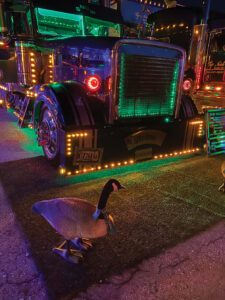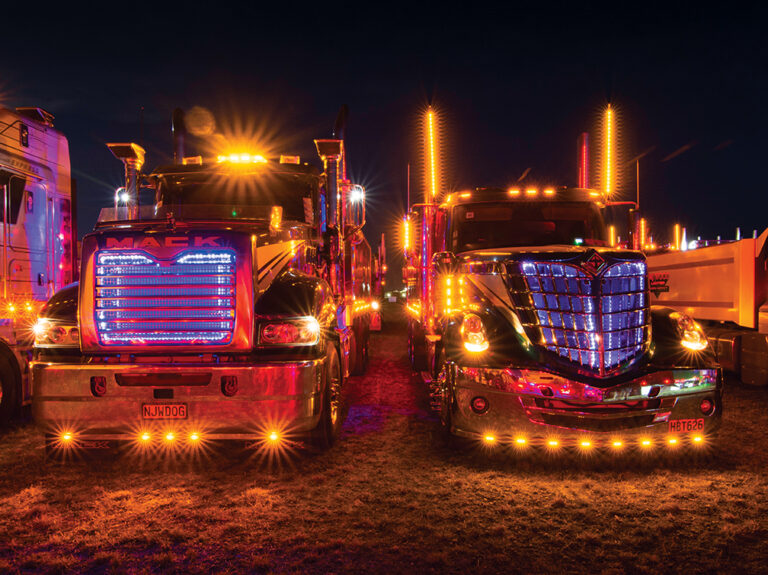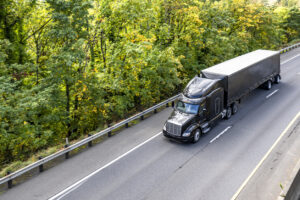Even from a distance, the lights tell you that an approaching vehicle is a commercial motor vehicle. If there’s a hill, even a small one, between you and the oncoming truck, you’ll see the amber clearance lights first — two at the front corners of the box or trailer, then the familiar five atop the cab arranged with a grouping of three in the middle and one on each side. Get a little closer, and it’s possible to determine whether the vehicle is a straight truck, a tractor-trailer or a tractor pulling doubles by the clearance lights down the side.
Table 1 of Federal Motor Carrier Regulations subpart 393.11 details the lighting and reflective device requirements for commercial motor vehicles manufactured after Dec. 25, 1968. Those regulations spell out the light colors and patterns that are familiar to every truck driver.
Some drivers and truck owners, however, go much further than the minimum legal requirements. Some install extra clearance lights, creating a line of lights so close together that, from a distance they, appear to be a solid line.
Others prefer lights that outline areas of the truck, like the bottom of the sleeper or the top of the bumper. Some like to highlight features, for example, positioning amber lights so they reflect off a chrome air filter housing.
Imagination is the limit, so long as lighting choices don’t violate the regulations. For example, red lights on the front end of a truck could confuse motorists, and would be illegal.
In fact, there’s a name for those magical numbers of lights that far exceed legal requirements. They’re called “chicken lights.” The term is sometimes used to poke fun at a driver who, in the opinion of someone else, uses an excessive number of lights. Other drivers, however, proudly refer to their own lighting schemes by the term.
While we’re on the subject of extra lights, let’s address a common CB myth often repeated by drivers without actual knowledge. As the fable goes, no matter how many lights are installed on the truck, they must all be working. Supposedly, someone knows someone who heard from someone else who had 250 lights on their trailer (well into “Rooster Cruiser” territory) and got ticketed because one of the bulbs had blown out.
It’s hogwash. As long as there are enough working lights to meet the requirements of 49 CFR 393.11, no laws have been broken.
There is, however, a downside to adding extra lighting: Each new lamp requires adding another connection to the wiring. Whether the connection is made by cutting and splicing wires or by using connection devices designed for this purpose, every new connection is susceptible to corrosion. If done right and checked frequently, however, problems can be avoided.
In recent years, LED (light-emitting diode) lamps have swarmed the market. Invented in 1962, the first LEDs gave off only low-intensity infrared light. Developments since then have resulted in a variety of colors and intensities, including some suitable for replacement headlight lamps.
The earliest use of LEDs for truck lighting, however, came in the form of LED tail and brake lights to replace the sealed-beam incandescent lamps used for tractors and trailers. The new LED models were brighter, quicker to activate, used far less electricity and lasted much longer than the old-style lights.
They were also expensive, 10 or more times the cost of an incandescent lamp, and theft was common. Drivers were often dismayed to discover four empty receptacles where tail and brake lamps were formerly located. Installations soon included the use of special screws or bolts designed to prevent theft.
These days, LED lamps are standard equipment on most vehicles. However, the use of LEDs has gone far beyond brake and tail lights. Nearly any light on the vehicle, including the headlamps, can now be powered by LEDs.

LEDs now come in a dazzling variety of colors, including units that contain diodes of different colors, allowing the owner to change the appearance of the truck at will. Red and amber lights used on the highway can become green, blue or another color when the truck is parked. Lights mounted underneath tractors and trailers light up the ground, adding to the effect.
Many of the truck competitions held at truck shows or as standalone events now include a light show. Some even present separate awards for best “legal” and “non-legal” displays. These are highly anticipated and usually well attended. If a little rain results in wet pavement, so much the better.
Even better, technology has made it possible to program LED lights to act in ways never before possible. Lights can change color, flash in predetermined patterns or in sequence at the direction of the driver. The lights competition at most shows features rows of trucks lit up like Christmas trees, only bigger and brighter. Displays are limited only by the owners’ imagination – and budget.
On the road, LEDs have paid off, too. Incandescent bulbs could blow out at any time, and most drivers carried at least one spare for each type of bulb. With more carriers offering drop-and-hook freight, a driver never knew when the next trailer might have a nonworking light, or several. A blown clearance light could mean a citation at the next scale house, or at least a trip-delaying inspection. LEDs, while not immune to breakdown, are much more reliable.
One area where incandescent bulbs have an edge, however, is in heat generation. In snowy conditions, most incandescent lights stay warm enough to melt accumulated snow from the lens area, often leaving a salty film behind. These headlamps were often warm enough to cause a burn if touched.
Because LEDs emit much less heat, drivers need to periodically clean snow away to keep the headlamp from being obscured. One LED manufacturer is even marketing lamps with a built-in heater. The Truck-Lite Company’s Supper 44 and 60 Series stop/tail/turn lights contain heating elements that activate when the temperature drops below 45 degrees.
With all of the available choices, truck lighting has become a trucking art form. There’s a nightly parade of lights on a highway, or at a truck stop, near you.
Cliff Abbott is an experienced commercial vehicle driver and owner-operator who still holds a CDL in his home state of Alabama. In nearly 40 years in trucking, he’s been an instructor and trainer and has managed safety and recruiting operations for several carriers. Having never lost his love of the road, Cliff has written a book and hundreds of songs and has been writing for The Trucker for more than a decade.








Thank you for explaining how LED lights are more reliable than standard incandescent ones. My son has been talking about getting some LED lights for his new truck. It seems like it might be a good investment for him. https://www.kgttc.com/services/truck-service/